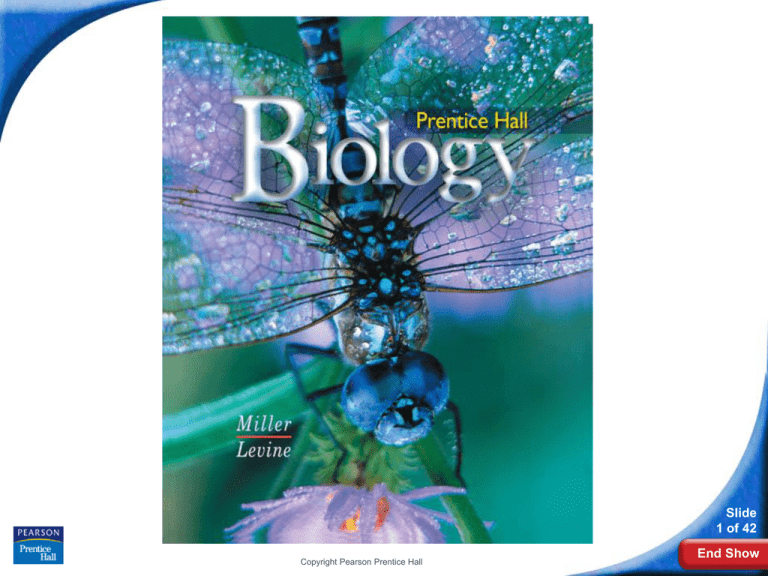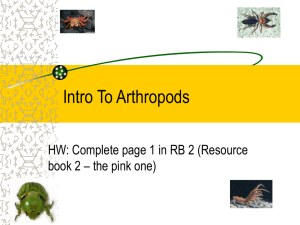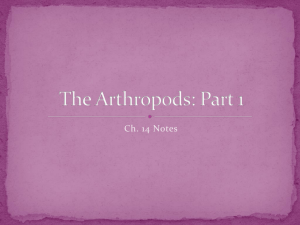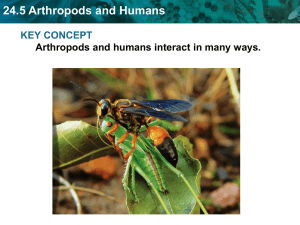
Biology
Slide
1 of 42
Copyright Pearson Prentice Hall
End Show
28–2 Groups of
Arthropods
Slide
2 of 42
Copyright Pearson Prentice Hall
End Show
28–2 Groups of Arthropods
How are arthropods classified?
Slide
3 of 42
Copyright Pearson Prentice Hall
End Show
28–2 Groups of Arthropods
28–2 Groups of Arthropods
Arthropods are classified based on the
number and structure of their body
segments and appendages—particularly
their mouthparts.
The three major groups of arthropods are:
• crustaceans
• spiders and their relatives
• insects and their relatives
Slide
4 of 42
Copyright Pearson Prentice Hall
End Show
28–2 Groups of Arthropods
Crustaceans
What are the distinguishing features of
the crustaceans?
Slide
5 of 42
Copyright Pearson Prentice Hall
End Show
28–2 Groups of Arthropods
Crustaceans
Crustaceans
Crustaceans are primarily aquatic.
This subphylum includes crabs, shrimps, lobsters,
crayfishes, and barnacles.
Slide
6 of 42
Copyright Pearson Prentice Hall
End Show
28–2 Groups of Arthropods
Crustaceans
Crustaceans typically have two pairs of
antennae, two or three body sections, and
chewing mouthparts called mandibles.
Abdomen
Cephalothorax
Mandible
First antenna
Second antenna
Slide
7 of 42
Copyright Pearson Prentice Hall
End Show
28–2 Groups of Arthropods
Crustaceans
The crayfish has a body plan that is typical of many
crustaceans.
The anterior cephalothorax is formed by fusion of
the head with the thorax.
Cephalothorax
Slide
8 of 42
Copyright Pearson Prentice Hall
End Show
28–2 Groups of Arthropods
Crustaceans
The thorax lies just behind the head and houses
most of the internal organs.
Slide
9 of 42
Copyright Pearson Prentice Hall
End Show
28–2 Groups of Arthropods
Crustaceans
The abdomen is the posterior part of the body.
Abdomen
Slide
10 of 42
Copyright Pearson Prentice Hall
End Show
28–2 Groups of Arthropods
Crustaceans
The carapace is the part of the exoskeleton that
covers the cephalothorax.
Carapace
Slide
11 of 42
Copyright Pearson Prentice Hall
End Show
28–2 Groups of Arthropods
Crustaceans
In a crustacean, the first two pairs of appendages are
antennae.
First antenna
Second
antenna
Slide
12 of 42
Copyright Pearson Prentice Hall
End Show
28–2 Groups of Arthropods
Crustaceans
The third pair of appendages are the mandibles.
A mandible is a mouthpart adapted for biting and
grinding food.
Mandible
Slide
13 of 42
Copyright Pearson Prentice Hall
End Show
28–2 Groups of Arthropods
Crustaceans
Decapods have five pairs of legs.
In crayfishes, the first pair of legs, called chelipeds,
have large claws that catch, pick up, crush, and cut
food.
Walking legs
Copyright Pearson Prentice Hall
Cheliped
Slide
14 of 42
End Show
28–2 Groups of Arthropods
Crustaceans
Behind these legs are four pairs of walking legs.
Walking legs
Copyright Pearson Prentice Hall
Cheliped
Slide
15 of 42
End Show
28–2 Groups of Arthropods
Crustaceans
Along the abdomen are several pairs of
swimmerets, which are flipperlike appendages used
for swimming.
Swimmerets
Slide
16 of 42
Copyright Pearson Prentice Hall
End Show
28–2 Groups of Arthropods
Crustaceans
The final abdominal segment is fused with a pair of
paddlelike appendages to form a large, flat tail.
Tail
Slide
17 of 42
Copyright Pearson Prentice Hall
End Show
28–2 Groups of Arthropods
Spiders and Their Relatives
What are the distinguishing features of
spiders and their relatives?
Slide
18 of 42
Copyright Pearson Prentice Hall
End Show
28–2 Groups of Arthropods
Spiders and Their Relatives
Spiders and Their Relatives
Horseshoe crabs, spiders, ticks, and scorpions
are chelicerates.
Chelicerates lack antennae.
Slide
19 of 42
Copyright Pearson Prentice Hall
End Show
28–2 Groups of Arthropods
Spiders and Their Relatives
Chelicerates have mouthparts called
chelicerae and two body sections, and
nearly all have four pairs of walking legs.
Fanglike
chelicera
Copyright Pearson Prentice Hall
Slide
20 of 42
End Show
28–2 Groups of Arthropods
Spiders and Their Relatives
Chelicerates have two pairs of appendages attached
near the mouth that are adapted as mouthparts.
Fanglike
chelicera
Copyright Pearson Prentice Hall
Slide
21 of 42
End Show
28–2 Groups of Arthropods
Spiders and Their Relatives
Chelicerae contain fangs and are used to stab and
paralyze prey.
Fanglike
chelicera
Copyright Pearson Prentice Hall
Slide
22 of 42
End Show
28–2 Groups of Arthropods
Spiders and Their Relatives
Pedipalps are longer than the chelicerae and are
usually modified to grab prey.
Pedipalp
Slide
23 of 42
Copyright Pearson Prentice Hall
End Show
28–2 Groups of Arthropods
Spiders and Their Relatives
Chelicerates are divided into two main classes.
• Merostomata includes horseshoe crabs.
• Arachnida, or arachnids, includes spiders, mites,
ticks, and scorpions.
Slide
24 of 42
Copyright Pearson Prentice Hall
End Show
28–2 Groups of Arthropods
Spiders and Their Relatives
Horseshoe Crabs
Horseshoe crabs first appeared more than 500
million years ago and have changed little since
that time.
They have chelicerae, five pairs of walking legs,
and a long spikelike tail that is used for
movement.
Slide
25 of 42
Copyright Pearson Prentice Hall
End Show
28–2 Groups of Arthropods
Spiders and Their Relatives
Spiders
Spiders capture and feed on animals ranging from
other arthropods to small birds.
Slide
26 of 42
Copyright Pearson Prentice Hall
End Show
28–2 Groups of Arthropods
Spiders and Their Relatives
Some spiders spin webs of a strong, flexible protein
called silk, which they use to catch flying prey.
Others stalk and then pounce on their prey.
Some spiders lie in wait and leap out to grab insects
that venture too near.
Slide
27 of 42
Copyright Pearson Prentice Hall
End Show
28–2 Groups of Arthropods
Spiders and Their Relatives
Spiders do not have jaws for chewing, they must
liquefy their food to swallow it.
Once a spider captures its prey, it uses fanglike
chelicerae to inject paralyzing venom into it.
Slide
28 of 42
Copyright Pearson Prentice Hall
End Show
28–2 Groups of Arthropods
Spiders and Their Relatives
All spiders produce silk.
Spiders spin silk into webs, cocoons for eggs, and
wrappings for prey.
Silk glands
Copyright Pearson Prentice Hall
Slide
29 of 42
End Show
28–2 Groups of Arthropods
Spiders and Their Relatives
They do this by forcing liquid silk through spinnerets,
which are organs that contain silk glands.
Spinnerets
Slide
30 of 42
Copyright Pearson Prentice Hall
End Show
28–2 Groups of Arthropods
Spiders and Their Relatives
Mites and Ticks
Mites and ticks are small arachnids that are often
parasitic.
Their chelicerae and pedipalps are specialized for
digging into a host’s tissues and sucking out blood
or plant fluids.
Ticks can transmit bacteria that cause serious
diseases.
Slide
31 of 42
Copyright Pearson Prentice Hall
End Show
28–2 Groups of Arthropods
Spiders and Their Relatives
Scorpions
Scorpions inhabit warm areas around the world.
Scorpions have pedipalps that are enlarged into
claws.
Scorpions chew their prey.
Slide
32 of 42
Copyright Pearson Prentice Hall
End Show
28–2 Groups of Arthropods
Insects and Their Relatives
What are the distinguishing features of
insects and their relatives?
Slide
33 of 42
Copyright Pearson Prentice Hall
End Show
28–2 Groups of Arthropods
Insects and Their Relatives
Insects and Their Relatives
Centipedes, millipedes, and insects are
uniramians.
Uniramians have jaws, one pair of
antennae, and unbranched appendages.
Slide
34 of 42
Copyright Pearson Prentice Hall
End Show
28–2 Groups of Arthropods
Insects and Their Relatives
Centipedes
Centipedes have from a few to more than 100
pairs of legs.
Most body segments bear one pair of legs each.
Centipedes are carnivores whose mouthparts
contain venomous claws that they use to catch
and stun or kill their prey.
Slide
35 of 42
Copyright Pearson Prentice Hall
End Show
28–2 Groups of Arthropods
Insects and Their Relatives
Millipedes
Millipedes have a highly segmented body.
Each millipede segment bears two pairs of legs.
Millipedes defend themselves by rolling up into a
ball or by secreting unpleasant or toxic chemicals.
They feed on dead and decaying plant material.
Slide
36 of 42
Copyright Pearson Prentice Hall
End Show
28–2
Click to Launch:
Continue to:
- or -
Slide
37 of 42
End Show
Copyright Pearson Prentice Hall
28–2
The two main groups of chelicerates are
a. spiders and scorpions.
b. horseshoe crabs and spiders.
c. horseshoe crabs and arachnids.
d. arachnids and insects.
Slide
38 of 42
End Show
Copyright Pearson Prentice Hall
28–2
Insects are part of the group
a. crustaceans.
b. uniramians.
c. chelicerates.
d. diplopods.
Slide
39 of 42
End Show
Copyright Pearson Prentice Hall
28–2
Most mites and ticks are
a. parasites.
b. predators.
c. herbivores.
d. detritovores.
Slide
40 of 42
End Show
Copyright Pearson Prentice Hall
28–2
Which of the following is NOT a typical
crustacean characteristic?
a. either two or three body segments
b. chewing mouthparts called mandibles
c. chelicerae that paralyze prey
d. two pairs of antennae
Slide
41 of 42
End Show
Copyright Pearson Prentice Hall
28–2
Spiders differ from the other arachnids because
they have
a. two major body segments and six legs.
b. three major body segments and eight legs.
c. two major body segments and eight legs.
d. three major body segments and six legs.
Slide
42 of 42
End Show
Copyright Pearson Prentice Hall
END OF SECTION







